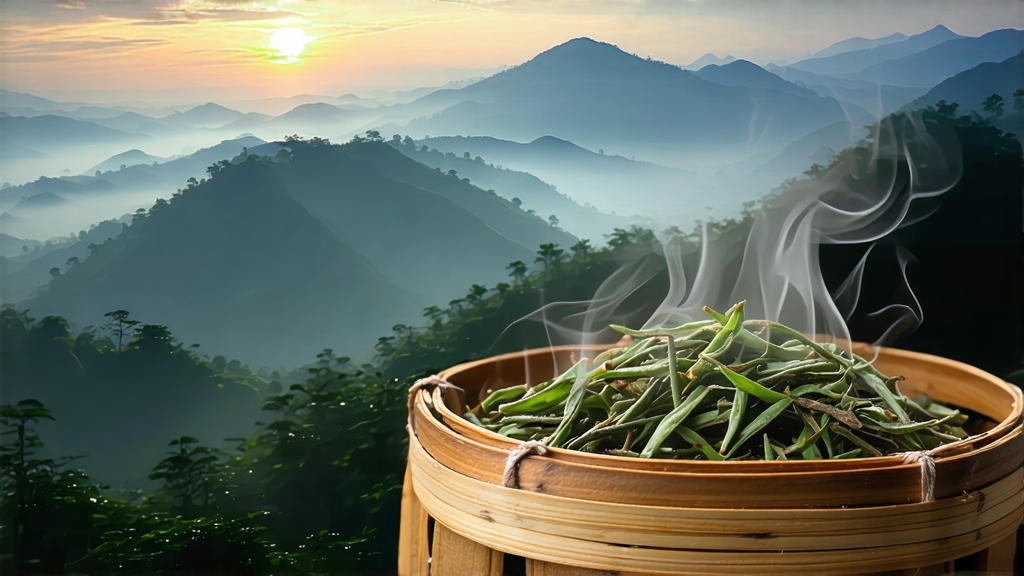
Tucked high above the Sichuan basin, where perpetual cloud veils the Min River gorge, lies Meng Ding Mountain, the cradle of the world’s oldest cultivated tea garden. It was here, during the Tang dynasty (618-907 CE), that Buddhist monks first coaxed the golden buds now known as Meng Ding Huang Ya—Meng Ding Yellow Bud—into a liquor so mellow that emperors later claimed every leaf as tribute. For a thousand years the tea travelled in silk-lined chests along the Jianmen Pass, reaching Chang’an, then Beijing, then vanishing behind palace walls. When the last Qing emperor abdicated in 1912, the recipe almost disappeared; only a handful of hereditary families on the mountain kept the stubborn craft alive, turning tiny lots in bamboo trays while the world rushed toward black and green. Today, as rare as a snow leopard, Meng Ding Huang Ya is re-emerging, a quiet ambassador of the almost-lost art of Chinese yellow tea.
What makes a tea “yellow” is not leaf colour but a slow, breath-held transformation known as men huang—“sealed yellowing.” After the buds are plucked—always one bud and its first unfolding leaf, never larger than 2.5 cm—they are lightly withered on hemp mats under the mountain’s cool mist. The moment the edge of each leaf wilts, workers transfer them to iron woks heated precisely to 160 °C. Fingers flick and press for no more than four minutes, just long enough to still the oxidative enzymes without driving off all moisture. The leaves emerge matte jade, still soft, smelling of rain-soaked chestnut. Now comes the step that defines the category: while green tea would be rushed into a hot dryer, yellow buds are wrapped. Dozens of layers of steamed yellow cotton cloth are folded over the warm leaves, creating a humid cocoon. Every forty minutes the bundles are opened, aired for thirty seconds, then re-wrapped. Over six to eight hours the chlorophyll gently degrades, tannins polymerise, and a whisper-thin coat of amino sugars forms on the leaf surface, giving the liquor its hallmark saffron hue and custard-like thickness. A final low-temperature bake fixes the flavour, after which the leaves are sorted by eye, discarding any that did not turn the colour of antique parchment.
The result is a tea that sits sensorially between green and oolong: greener than a white, yet rounder than a spring Long Jing, with none of the grassy bite that marks early-harvest greens. Dry, the buds resemble tiny golden fishhooks, downy at the stem, releasing aromas of fresh maize and orchid when warmed in the palm. Infused, they dance upright in the glass, slowly unfurling like miniature fireworks, tinting the water the colour of late-afternoon sunlight on limestone.
To brew Meng Ding Huang Ya respectfully, one must first unlearn the violence often shown to delicate teas. Begin with mountain spring water whose total dissolved solids sit between 30–80 ppm; anything harder will flatten the subtle sweetness. Bring the water to 85 °C—not the rolling boil demanded of pu-erh, nor the 75 °C suited for gyokuro. Pre-heat a tall glass or a 150 ml gaiwan; the gentle heat stabilises the brew and awakens the buds. Use one gram of leaf for every twenty millilitres of water, an easy rule that translates to roughly five buds per cup. Pour the water in a thin stream, grazing the glass wall so the leaves revolve slowly. Cover, but do not seal; yellow tea likes a breath of oxygen during its first thirty seconds. Decant completely into a fairness pitcher, leaving the buds exposed to air for a moment—this brief pause encourages the next infusion to open with renewed fragrance. The first steeping tastes of steamed zucchini blossom and raw macadamia; the second, of custard apple and wet slate; the third, of warm beeswax disappearing into a clean, mineral finish. Four infusions is common, five if the buds are particularly plump, each lengthened by ten seconds.
Tasting yellow tea is an exercise in listening for quiet voices. Swirl the liquor gently; observe the meniscus—an opalescent ring signals successful yellowing. Inhale with mouth slightly open, letting the cool air carry esters to the retronasal passage; you may detect a note reminiscent of just-polished lacquer, a scent memory embedded in Chinese temples. Sip, hold for three heart